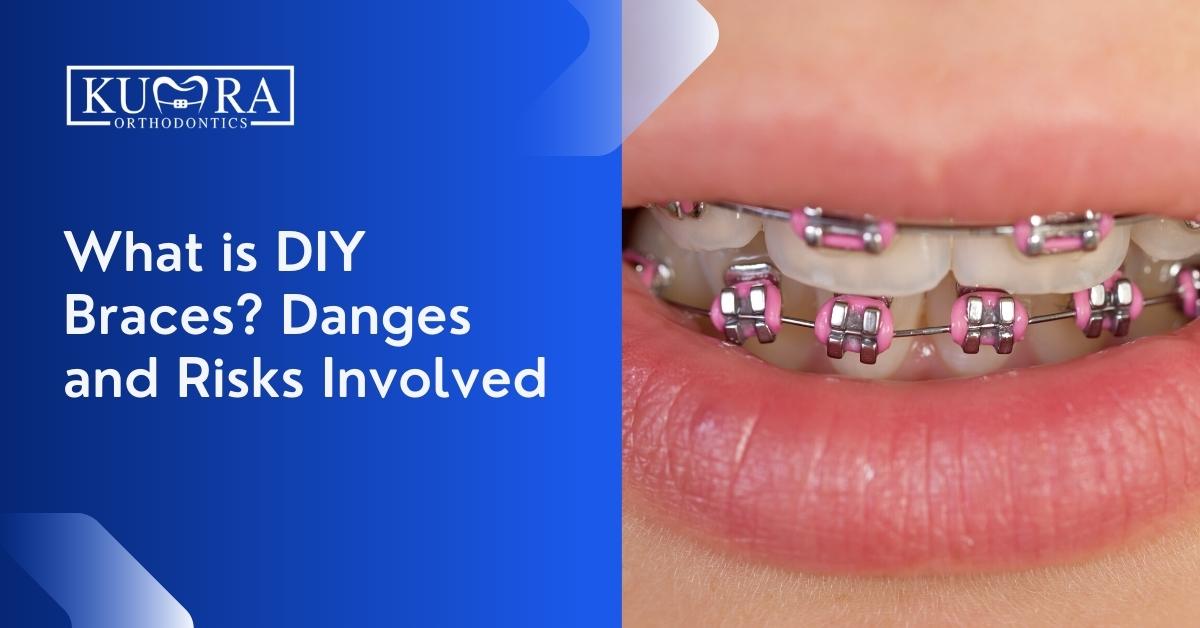For many people, do-it-yourself (DIY) braces appear to be an easy, straightforward, and affordable way to achieve straight teeth. For instance, you might form your teeth with paper clips or other implements. Indeed, this treatment can do more damage to your teeth than braces would, which is why it is so risky.
As the popularity of do-it-yourself braces increases, so does the concern of skilled specialists. Orthodontists members of the American Association of Orthodontists (AAO) have stated that 13% of their patients attempted at-home tooth straightening.
What are DIY braces
DIY braces are braces that have been applied to the teeth by someone who is not a dental professional. DIY braces come in various shapes and sizes, including the use of gap bands (rubber hair bands) strung together to bring teeth closer together and bridge a gap between them.
Braces made at home are not safe. In the case of do-it-yourself procedures, it’s tempting to dismiss doctors’ recommendations as reflecting improbable scenarios. However, the risk of irreversible harm is extremely high when it comes to do-it-yourself braces.
Additionally, it would help if you remembered that selling and distributing non-professional do-it-yourself braces is against the law, and violators may face fines and jail time.
Needing an orthodontic appointment?
Visit Kumra Orthodontics Washington, DC or Kumra Orthodontics Stafford, VA, and request an appointment with us!
Dangers and risks of DIY braces
A basic rubber band may not appear to be a significant item. However, the band can easily become trapped behind the gums. This interrupts the tooth’s nerve/blood supply, resulting in tooth loss. Alternatively, it might create a major infection, resulting in tooth or bone loss.
The AAO has issued a warning against gap bands and do-it-yourself braces because they pose a severe health risk. Neither you nor your teenagers must experiment with this new fad. Indeed, the AAO advises that gap band-related tooth loss can cost more than $20,000. Unfortunately, teens who lose teeth due to gap bands must wait until they reach the age of 18 to have dental implants. Moving teeth without dental supervision can lead to:
TMJ (Temporomandibular Joint Disorder) Disorder
Teeth misalignment can result in TMJ, a painful syndrome affecting the jaw that can cause limited jaw movement, frequent headaches, ear and hearing issues, and neck and shoulder muscular spasms.
Most of the time, the pain and discomfort associated with TMJ issues are temporary and can be alleviated with self-care or nonsurgical treatments. Surgery is generally reserved for patients who have failed to improve with conservative approaches. However, some persons with TMJ issues may benefit from surgical treatment.
Root Resorption
Root resorption is the body’s breakdown and absorption of the tissues around the tooth. To put it another way, the body begins to eat its teeth.
A physical injury to the teeth, such as a blow, chemical exposure, or a burn, is the most common cause. Trauma causes inflammation, which leads to the body’s natural healing process. This may also be caused by pulp necrosis, dental therapy, orthodontics, or non-professional tooth whitening. Too much pressure on the teeth can shorten and weaken the roots, resulting in tooth instability and eventual tooth loss.
Gum Recession
Gum recession is a condition in which the gum tissue that covers the teeth recedes, revealing more of the tooth’s root. Because of the pockets or gaps created between the teeth and gum line due to gum recession, harmful germs can grow easily.
Fractured Teeth
When a crack occurs in your tooth, you have a fractured tooth, also known as cracked or cracked tooth syndrome (CTS). The crack may be minor and unnoticeable in certain cases. Your tooth may also crack or split as a result.
Pain when biting and chewing (particularly upon release) and sensitivity to heat or cold are common symptoms of fractured teeth. In some circumstances, you may feel no discomfort at all, while you may feel a lot of pain in others.
Tooth Loss
The roots of teeth can die or become loose, causing them to fall out. Losing a tooth is damaging to your dental health and your appearance. The teeth closest to a gap in the gums may shift to fill in the gap, increasing the risk of infection. The risk of long-term damage to your mouth is exacerbated if you lose several teeth at once.
Certified orthodontists utilize equipment that has been subjected to stringent testing to assure its safety and efficacy. It takes extensive education, training, and hands-on experience for an orthodontist to diagnose, supervise, and treat orthodontic patients effectively. They can avoid hurting your teeth or gums by knowing how the jaw, mouth, and tooth movement function in concert.
Contact Kumra Orthodontics to learn more about the dangers of DIY braces
DIY braces are bad for your teeth and your health. These homemade devices may cause pain or damage the jaw and TMJ, resulting in chronic headaches and neck issues. As a result of not brushing away food particles, a dry mouth can cause tooth damage.
Consider consulting with Kumra Orthodontics beforehand to learn about the risks and costs of using one of these dental appliances.


